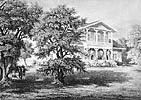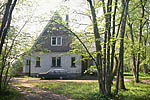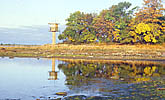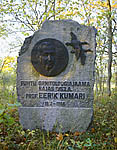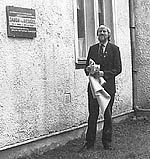Landmarks from Puhtu's HistoryIn 1478 Puhtu (Holm zu Pucht) is mentioned for the first time in a document that records the distribution of the inheritance of the lord of the manor. At that time Puhtu belonged to the Uexküll family. In the middle of the 18th century the owner of Old Virtsu manor, the district magistrate and well-known patron of the arts, Carl Thure von Helwig (1741-1810), built his summer residence, which included a garden and park, on the islet. The park and summerhouse were skilfully combined with the natural forest without destroying the unique beauty of the place.
In 1813 Carl Thure von Helwig’s widow Wilhelmine erected a monument, constructed by her husband, in honour of the German poet Friedrich von Schiller who was a family friend. To all knowledge this is the worlds oldest surviving memorial to Schiller. It stands in its original position in the forest near the northern coast of Puhtu. Carl Thure von Helwig erected many tomb monuments for the more famous members of his family, such as Wrangel, Tisenhausen and Kursell. These were originally positioned along the path leading to the von Helwig family cemetery at Toonenina on the eastern side of Puhtu. Now they are located on the grassy area between the biology field station and the bird-watching tower. From 1928 to 1940 Puhtu`s owner was Professor Jacob von Uexküll from Hamburg University and there he spent almost every summer between 1929 and 1939. Between 1884 and 1890 Jacob von Uexküll studied history, mineralogy and zoology at Tartu University. He worked at Heidelberg and Hamburg Universities and at the Naples Biology Field Station. During the 1930s he built a summerhouse on the southern tip of Puhtu. In 1940 he settled on the island of Capri and died there in 1944.
In 1934 Jacob von Uexküll invited Count Alexander von Keyserling, a great nature lover and amateur ornithologist, to live on the islet as guardian and caretaker. He lived there until 1939. In 1950 a zoological and botanical reserve was created on Puhtu at the instigation of the Estonian Academy of Sciences, Institute of Biology and Zoology (ZBI). Since the preservation of nature was not yet the responsibility of the state, Puhtu was cared for by the ZBI. Puhtu could now boast the first nature reserve to be established in post war Estonia. In 1953 at the instigation of Prof. Eerik Kumari, Puhtu Ornithological Station was established. That year also saw the beginning of the systematic study of bird migration in Estonia. In 1959 the Virtsu, Laelatu and Puhtu Botanical and Zoological Reserve was created, to which Puhtu belongs as an especially protected area. This special status is mainly because of the number of waterbirds in the surrounding area, the existence of important transit sites for migrating waterbirds, the unique association of broadleaf trees in its forests and the research possibilities in the area.
In the autumn 1989 the European parliamentarian and creator of the Alternative Nobel Prize, Jacob von Uexküll Jr., unveiled a memorial tablet in honour of his namesake and grandfather at the Puhtu Biology Field Station. Jacob von Uexküll Jr., who established the Estonian Renaissance Award, has dedicated himself to the search for balance in the world.
Since the spring 1994 Tartu University animal ecology students have carried out their summer field-practice at Puhtu Biology Field Station. Since 1995 the Virtsu, Laelatu and Puhtu Reserve has been part of the Matsalu Nature Reserve. |
|||||||||||||
